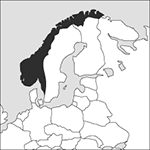
Source: MAPS IN MINUTES™ © RH Publications (1997)
Capital:
Oslo
Area:
323,802 sq km (125,021 sq miles)
Population:
4,722,701 (2013 est)
Currency:
1 krone = 100 ore
Religions:
Church of Norway (Evangelical Lutheran) 82.1%; other Christian 5.7%; Muslim 2.3%
Ethnic Groups:
Norwegian 94.4%; other European 3.6%
Languages:
Bokmal Norwegian, Nynorsk Norwegian (both official); Sami; Finnish
International Organizations:
UN; NATO; EFTA; OECD; Council of Europe; OSCE; WTO
A country forming the north-western part of Scandinavia in northern Europe.
Physical
Norway’s extensive coast, fringed with innumerable small islands, stretches from the Arctic Ocean to the North Sea. Inland it borders on Sweden (a long boundary), Finland, and Russia. It is mountainous, rising to 2470 m (8104 feet) in the Jotunheimen range. Its warm climate is caused by the Gulf Stream, which usually keeps the fiords from freezing.
Economy
Norway has one of the world’s largest reserves of aluminium, though the main resource is North Sea oil and natural gas; in the north, in the Arctic, the Svalbard (Spitsbergen) archipelago contains rich deposits of coal. The extraction of North Sea oil and natural gas increased sharply in the 1970s and 1980s, and they make up about half of exports and provide a quarter of government revenue. Oil production has been declining since 2001 though this has been offset by the continuing growth of gas production, making Norway the world’s third-largest exporter of gas after Russian and Qatar. With the fall in oil prices, 2015 was the first year when the value of gas exports was higher than that of oil. Norway’s economy is diverse, however, with other industries including food processing, shipbuilding, paper products, metals, chemicals, timber, mining, textiles, and fishing. Agriculture is limited, since only 3% of land area is cultivable. Norway invests some state oil revenues in one of the world’s largest sovereign wealth fund, which by 2016, had grown to over $800 billion.
History
Norway was inhabited in prehistoric times by primitive hunting communities. Rivalry between chiefs, and the desire for land provoked excursions by the Norwegian Vikings as far as England, Greenland, and Iceland. Political organization strengthened under Harald Fairhair (c.900) and under Olaf I, who brought Christianity. Olaf II furthered the work of Christian conversion, but was killed in a battle with the Danes. Danish rule (1028–35) followed, and thereafter civil war, and, in 1066, an unsuccessful expedition to assert Harald Hardrada’s claim to the English throne. The reign of Haakon IV brought order and, from 1254, Norway traded with the Hanseatic League. In 1397 the Union of Kalmar brought Norway, Sweden, and Denmark together under a single monarch. Danish rule resulted in conversion to the Lutheran Church. The Union was dissolved in 1523, though Norway was ruled by Danish governors until 1814 when it was ceded to Sweden. The country had established its own parliament (Storting) in 1807. A literary revival and a new national consciousness brought demands for complete independence. Responsible government was granted in 1884, and universal male suffrage in 1898. Finally, union with Sweden was unilaterally declared dissolved in June 1905, and Prince Charles of Denmark elected as Haakon VII. A Liberal Party government introduced women’s suffrage and social reform, and maintained neutrality during World War I. In World War II, the Germans invaded, defeating Norwegian and Anglo-French forces at Narvik in 1940 and imposing a puppet government under Vidkun Quisling. In 1945 the monarchy, and a Labour government, returned. Norway withdrew its application to join the European Economic Community (1972) after a national referendum, while the exploitation of North Sea oil in the 1970s gave a great boost to the economy. Norwegians voted against joining the European Union in a referendum held in 1994; the country remains in EFTA and the European Economic Area. At the start of this century, a centrist coalition was in power, but Labour, the traditional party of government, returned in 2005 at the head of a socialist coalition, as voters were increasingly concerned that Norway’s wealth was not being translated into even better public services. In 2009, the same coalition was returned, though with a smaller majority. On 22 July 2011 a lone right-wing terrorist, Anders Breivik, set off a bomb in Oslo and then shot over 60 people dead at a Labour Party youth camp on the island of Utøya. In 2013, a right-of-centre coalition led by the Conservative Party under Erna Solberg came to power as a minority government with support from the anti-immigration Progress Party.
- sodium-sulphate soundness test
- sodium sulphide
- sodium sulphite
- sodium-sulphur cell
- sodium superoxide
- sodium thiosulphate
- sodium-vapour lamp
- sodium–sulphur cell
- SOE
- SOFAR channel
- SOFIA
- soft acid
- soft base
- soft budget constraint
- soft clipping
- soft condensed matter
- soft copy
- soft currency
- soft determinism
- soft fill
- soft font
- soft gamma-ray repeater
- soft iron
- soft keyboard
- soft landing